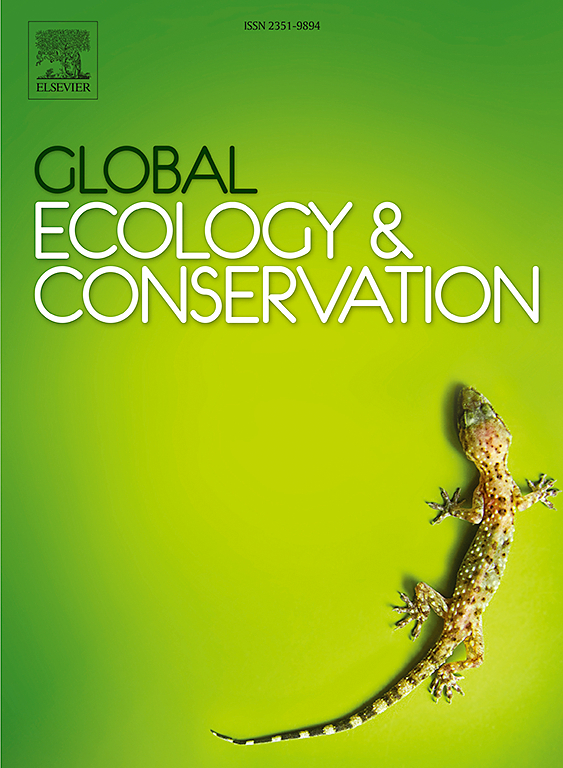Assessment of heavy metal exposure risk to aquatic birds in the key wetland habitats of the Yellow River (China), using an integrated model
IF 3.5
2区 环境科学与生态学
Q1 BIODIVERSITY CONSERVATION
引用次数: 0
Abstract
Heavy metal pollution poses a growing threat to wetland ecosystems, impacting their structure and function. Chenqiao Wetland and Qinglong Lake (Henan, China), key bird habitats in the middle and lower reaches of the Yellow River, were analyzed for heavy metal contamination. We assessed the exposure risks of heavy metals (Cu, Cd, Pb, Cr, and Zn) to aquatic birds using an integrated model that considered multiple intake variables: soil intake rate (Is), water intake rate (Iw), plant intake rate (Idf), and prey items intake rate (aquatic animals, Idf). Results revealed significant variation in heavy metal pollution across sampling points, with Cd presenting the highest potential ecological risk in soil. Bioaccumulation coefficients were notably higher in benthic invertebrates compared with fish. Omnivorous and herbivorous birds exhibited significantly higher heavy metal exposure doses (Ej) than carnivorous birds, with the exception of Cr. Among all elements, Zn exhibited the highest Ej, while Pb and Cr posed a high exposure risk (hazard quotient [HQ] > 2) across both food and soil pathways in both omnivorous and herbivorous aquatic birds, which were predominantly exposed to Cu, Zn, Pb, and Cr through plants rather than soil. Conversely, the high Cr HQ in omnivorous and carnivorous birds was primarily associated with the consumption of aquatic animals. This study highlights the importance of considering both food and soil pathways when assessing heavy metal exposure risks in aquatic birds. These findings provide valuable insights for developing strategies to mitigate heavy metal pollution in wetland ecosystems and protect bird populations.
基于综合模型的黄河重点湿地水禽重金属暴露风险评价
重金属污染对湿地生态系统的威胁日益严重,影响湿地生态系统的结构和功能。对黄河中下游主要鸟类栖息地陈桥湿地和青龙湖进行了重金属污染分析。我们使用综合模型评估了水禽对重金属(Cu、Cd、Pb、Cr和Zn)的暴露风险,该模型考虑了多个摄入变量:土壤摄入量(Is)、水摄入量(Iw)、植物摄入量(Idf)和猎物摄取率(水生动物,Idf)。结果显示,各采样点重金属污染差异显著,其中镉在土壤中具有最高的潜在生态风险。底栖无脊椎动物的生物积累系数明显高于鱼类。除Cr外,杂食性和草食性鸟类的重金属暴露剂量(Ej)均显著高于肉食性鸟类,其中Zn的Ej最高,Pb和Cr的暴露风险较高(危害商[HQ];2)杂食性和草食性水鸟的食物和土壤途径均存在Cu、Zn、Pb和Cr的暴露,主要通过植物而非土壤。相反,杂食性和肉食性鸟类的高Cr HQ主要与食用水生动物有关。这项研究强调了在评估水禽重金属暴露风险时考虑食物和土壤途径的重要性。这些发现为制定减轻湿地生态系统重金属污染和保护鸟类种群的策略提供了有价值的见解。
本文章由计算机程序翻译,如有差异,请以英文原文为准。
求助全文
约1分钟内获得全文
求助全文
来源期刊

Global Ecology and Conservation
Agricultural and Biological Sciences-Ecology, Evolution, Behavior and Systematics
CiteScore
8.10
自引率
5.00%
发文量
346
审稿时长
83 days
期刊介绍:
Global Ecology and Conservation is a peer-reviewed, open-access journal covering all sub-disciplines of ecological and conservation science: from theory to practice, from molecules to ecosystems, from regional to global. The fields covered include: organismal, population, community, and ecosystem ecology; physiological, evolutionary, and behavioral ecology; and conservation science.
 求助内容:
求助内容: 应助结果提醒方式:
应助结果提醒方式:


